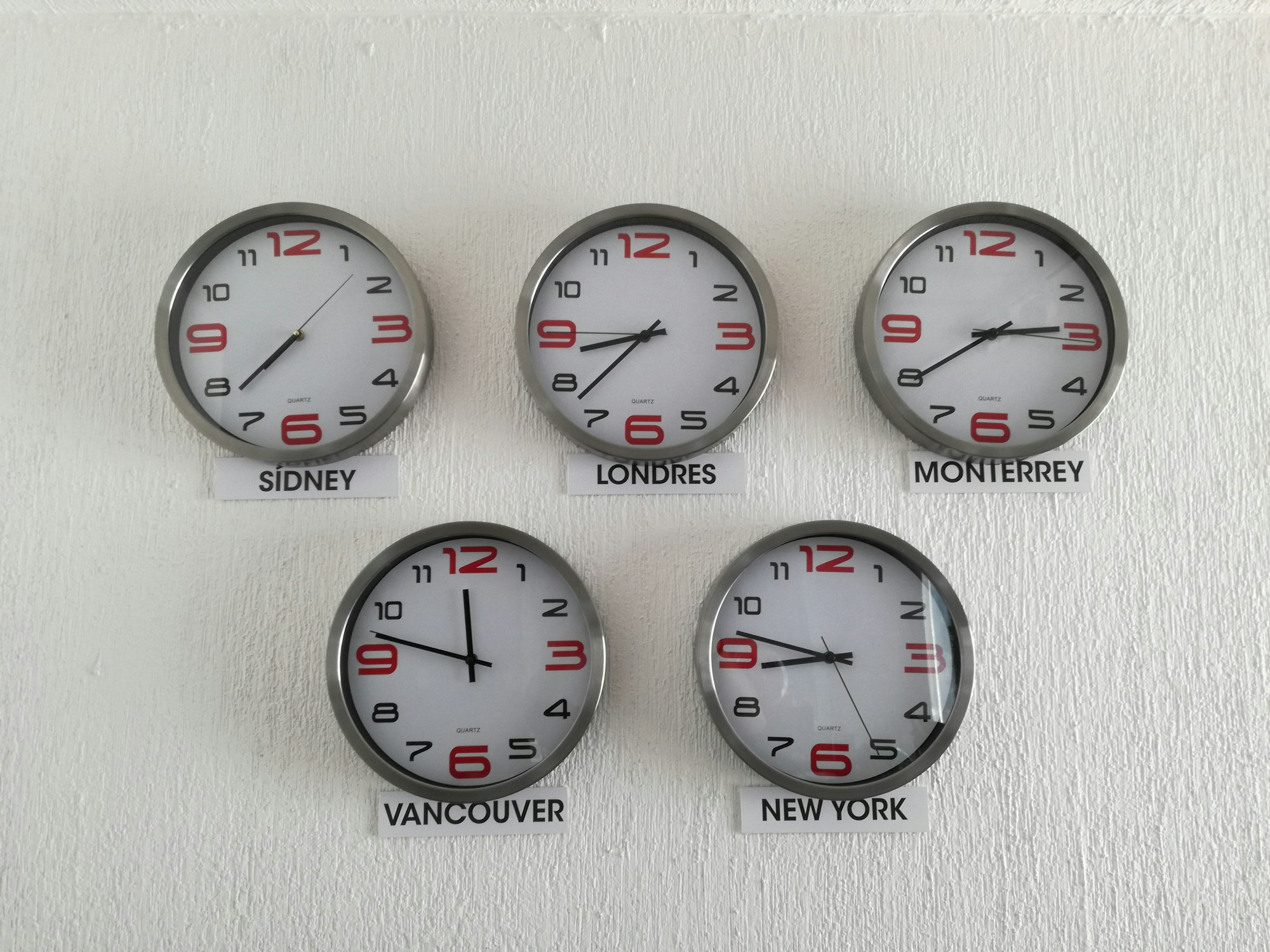Working Remotely in Different Time Zones: 6 Tips for Remote Work Success

As a remote worker, I've had the opportunity to work with amazing clients and colleagues worldwide. But there were times that I really struggled with the time zone difference.
Over the years, though, I've developed a few tips and tricks that have helped me navigate the complexities of working across different time zones. And today, I'm excited to share these tips with you, and I hope this will help you succeed in facing this popular concern among aspiring remote workers and digital nomads.
Whether you're working on a large freelance project, collaborating with colleagues, or managing a team remotely, implementing these 6 tips will optimize your productivity and help you master time zone management. Ready? Let's dive in.
The Challenges of Working in a Different Time Zone
We know that working from the other side of the world is certainly an exciting experience and the benefits are undeniable.
It gives you this unique chance to work with people worldwide while gaining exposure to new cultures and perspectives. And this is just priceless.
However, we can't also deny the fact that it also comes with its own set of challenges too. Let's look at them one by one and how we can overcome them.
Communication Barriers

One of the most significant challenges of working in a different time zone is the potential for communication barriers. When your colleagues or clients are asleep while you're awake, it can be difficult to get the information you need or to convey your own ideas effectively. This can lead to misunderstandings and delays in project timelines.
To overcome this substantial obstacle, it's important to utilize technology to its fullest potential. This might mean using instant messaging platforms like Slack or Microsoft Teams to stay in touch throughout the day or scheduling regular check-ins to ensure that everyone is on the same page. It's also important to be proactive in your communication, asking questions and seeking clarification when necessary.
Another way is to establish clear guidelines and expectations for communication. This might mean setting specific times for check-ins or establishing protocols for responding to emails and messages. By establishing clear communication guidelines, everyone involved can feel more confident in their ability to collaborate effectively.
Scheduling Conflicts

Scheduling conflicts can also arise when working in a different time zone. It may be difficult to find an overlap in work hours, especially if there is a significant time difference between you and your colleagues or clients. This can make it challenging to schedule meetings and collaborate on projects.
Adjusting your work hours or finding a compromise that works for everyone involved may be necessary to navigate scheduling conflicts. This might mean starting work earlier or later in the day or being flexible with deadlines and project timelines. It's also important to keep an open mind and be willing to adapt to ensure a successful team collaboration.
Maintaining Work-Life Balance

When you're working remotely in a different time zone, it can be easy to blur the lines between work and home life. This can lead to burnout and a lack of productivity. To maintain a healthy work-life balance, you should make sure to establish clear boundaries and always prioritize self-care.
This might mean taking breaks throughout the day to stretch, meditate, or exercise and setting aside time for hobbies and other non-work-related activities. Finally, another important aspect is establishing a dedicated workspace and avoiding working from your bed or couch. By creating a physical separation between work and home life, you can help to maintain a healthy balance and avoid burnout.
6 Tips for Remote Working Remotely in Various Time Zones
Now that we learned the challenges of working remotely through a different time zone let's see a few tactics that you can adopt to master time zone management.
1. Plan Ahead

The first step to successfully working through various time zones is planning ahead. When you're working with a global team or a client, it's important to familiarize yourself with their local time and time zone differences. Use remote work tools like World Time Buddy or Every Time Zone to help you visualize and plan your day accordingly.
Before scheduling meetings or setting deadlines, consider the time differences and find a suitable time that works for everyone. Avoid last-minute changes, as this can cause confusion and stress for your colleagues or clients. Planning ahead will make sure everyone is well-informed and prepared for meetings and deadlines.
2. Set Clear Expectations

As a remote worker, you surely realize by now how clear communication is quintessential. Be transparent about your work hours, availability, and response times. Let your clients or colleagues know how soon they can expect to hear back from you and if there will be any delays due to time zone differences.
It's also important to set expectations for projects and tasks. Clearly define goals, roles, responsibilities, and deadlines so that everyone on the team knows what needs to be done and by when.
3. Leverage Technology

Technology is your best friend when working remotely across time zones. Use tools like Slack, Microsoft Teams, Monday.com, or Notion to keep everyone connected, organized, and updated on the latest project developments. Cloud-based platforms like Google Drive or Dropbox allow for seamless sharing and storage of documents, presentations, and spreadsheets.
When scheduling meetings, tools like SimplyBook.me or Calendly can help you find a time that works for everyone. Remember to also take advantage of video conferencing tools like Zoom or Google Meet for face-to-face communication, which can help build rapport and trust among team members.
4. Be Flexible and Compromise

Working across time zones requires a certain level of flexibility and compromise. Sometimes, you may need to adjust your schedule to accommodate a meeting or deadline for a colleague in a different time zone. Be open to these adjustments, as they can help create a more harmonious and productive work environment.
Also, show empathy and understanding towards your team members or remote employees, as they may be making similar sacrifices to accommodate your needs. Maintaining open lines of communication and a positive attitude can go a long way in building strong relationships with your colleagues.
5. Use Asynchronous Communication

Asynchronous communication is a remote worker's secret weapon. This means sending messages, emails, and updates without expecting an immediate response. Using asynchronous communication tools like email, messaging apps, or project management systems gives your colleagues the flexibility to respond when it's most convenient for them.
The most time-saving tool that I feel recommending here is Loom. With this awesome tool, you can just video-record yourself and your screen and go through presentations, audits, implementations, walk-throughs, or anything you want to share with your team or colleagues. Then, you just need to share a link with them, and they will be able to view the video when and as many times as they want. And you will even be notified any time that anyone sees your link! This is a true gem for digital nomads wanting to be more productive and avoid endless (and sometimes useless) meetings.
All these async communications tactics reduce pressure and help create a more relaxed work environment, making it easier for everyone to balance their professional and personal lives.
6. Always Prioritize Self-Care

A last tip here is about self-care. We saw how working remotely across various time zones can be both rewarding and challenging. It's important to take care of yourself and establish a healthy work-life balance. Setting boundaries by having a designated workspace, establishing regular work hours, and taking breaks throughout the day are just a few tactics that you should be following to safeguard your personal health.
Remember to always prioritize physical and mental well-being. Exercise, eat well, and practice mindfulness techniques like meditation or deep breathing. By taking care of yourself, you'll be better equipped to handle the challenges of working remotely through various time zones and enjoy traveling the world. Trust me, your future self will thank you later.
You Can Do It

By following the six tips we shared in this article, you will have the tools to navigate the complexities of time zones and maintain a healthy work-life balance. Don't forget, therefore, to plan ahead, set clear expectations, leverage technology, be flexible, compromise, use asynchronous communication, and prioritize self-care.
With a little bit of planning and adaptability, you'll find that working with clients and colleagues from around the world is an extraordinarily enriching experience that can help you grow both personally and professionally. Embrace the challenge and take advantage of the opportunities that remote work has to offer, and you'll be well on your way to building a successful career that spans the globe.
Ready To Master Remote Work Across Different Time Zones?
If you want more digital nomad guides like these, sign up for our free newsletter and get upcoming articles straight to your inbox!
Freaking Nomads is supported by you. Clicking through our links may earn us a small affiliate commission, and that's what allows us to keep producing free, helpful content. Learn more







 Travel tips, hacks, and news
Travel tips, hacks, and news Exclusive travel discounts
Exclusive travel discounts Offers and promotions
Offers and promotions Digital nomad inspiration
Digital nomad inspiration Latest articles form our blog
Latest articles form our blog
Comments ()